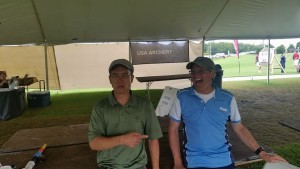Another USA Archery Outdoor Championship has been concluded. As in any competition there are many things to reflect upon and action steps to take to my next competition.
My biggest reflection is how much fun I had and how good the camaraderie was between competitors. We are fierce competitors, but even better friends. We want nothing more than to beat all comers, but revel in our competition’s success. That is special. It doesn’t happen in all classes of archery competition, but in the Masters class, we really do value the people and the opportunity to compete. Win, lose, or draw, we relish the experience.
As I said, the competition was keen and I shot very poorly to start. I couldn’t find my shot. BUT and this is a very large point, I did not stray from my fundamentals and my shooting keys. In time, the feel of the shot returned and I competed quite effectively. By the end of the qualification round I moved from an also ran 4th to almost edging out the 2nd place finisher. One must be steadfast in what makes their shot tick. It hasn’t changed just because things are not going well. On the start of the second day of qualifications I knew my shot was in good shape and I shot well for the balance of the tournament.
Day three was the start of the so called Olympic Round. These are head to head matches, in a single elimination, bracket type arrangement. Anything can happen and often times better archers are eliminated. It is a challenge and lots of fun. It’s all or nothing and you need to bring it……..right now!! I was very fortunate and won my matches to capture the crown. The confidence I acquired in day two carried over and I shot very capably. Other very talented shooters got knocked out, but it was the top 4 seeds in the medal matches.
Off the shooting field, we really had a good time. All though there were numerous weather delays, everyone maintained a positive attitude. There were dinners filled with great conversation and pretty good BBQ as well.
Tournament shooting is so much more than winning or losing. Embrace the experience. Make new friends. Laugh a lot. Compete hard. Learn about your shot and get excited for the next opportunity!




